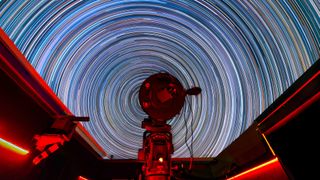
An eight-hour long exposure of the night sky captured from the Dark Sky Alqueva Reserve in Portugal by astrophotographer Miguel Claro.
(Image credit: Miguel Claro)
Miguel Claro is a professional photographer, author and science communicator based in Lisbon, Portugal, who creates spectacular images of the night sky. As a European Southern Observatory Photo Ambassador and member of The World At Night and the official astrophotographer of the Dark Sky Alqueva Reserve, he specializes in astronomical “Skyscapes” that connect both Earth and the night sky.
The night sky has never looked so colorful.
When looking at the stars in the night sky, it can be difficult to distinguish the colors of individual stars with our naked eyes. However, taking very long exposures of the night sky can reveal the true nature of our colorful sky, as well as allowing us to visualize Earth’s rotation and the motion of the celestial sphere.
This wide-angle scene is composed of eight hours of consecutive long exposures captured from the Dark Sky Reserve in Alqueva, Portugal. It reveals the motion of stars centered around the north star, Polaris, depicting them as colorful trails shining in different hues of blue, white, yellow and even orange.
Related: Nearby star factory shines in stunning James Webb Space Telescope photo

An eight-hour long exposure of the night sky captured from the Dark Sky Alqueva Reserve in Portugal by astrophotographer Miguel Claro. (Image credit: Miguel Claro)
The different colors of the stars are directly related to the type and temperature of each one. The hottest stars appear in blues, while the coldest ones appear as reddish-orange hues. Astronomers classify stars based on their spectral characteristics — that is, what frequencies and wavelengths of the electromagnetic spectrum they emit, including visible light.
Visible light from stars can be split into a spectrum using prisms and optical elements known as diffraction gratings. The amount of each wavelength of light can indicate the presence of different chemical elements or isotopes, and the relative abundance of each element varies with the temperature of a star’s photosphere, or visible surface. Thus, the visible light of each star can offer a way to measure its temperature and density.
Editor’s Note: If you snap your own photos of the stars or night sky and would like to share them with Space.com’s readers, send your photo(s), comments, and your name and location to [email protected].
Join our Space Forums to keep talking space on the latest missions, night sky and more! And if you have a news tip, correction or comment, let us know at: [email protected].
Breaking space news, the latest updates on rocket launches, skywatching events and more!
Miguel Claro is a professional photographer, author and science communicator based in Lisbon, Portugal, who creates spectacular images of the night sky. As a European Southern Observatory photo ambassador, a member of The World At Night and the official astrophotographer of the Dark Sky Alqueva Reserve, he specializes in astronomical skyscapes that connect Earth and the night sky.
>>> Read full article>>>
Copyright for syndicated content belongs to the linked Source : Space.com – https://www.space.com/stars-colorful-night-sky-miguel-claro































